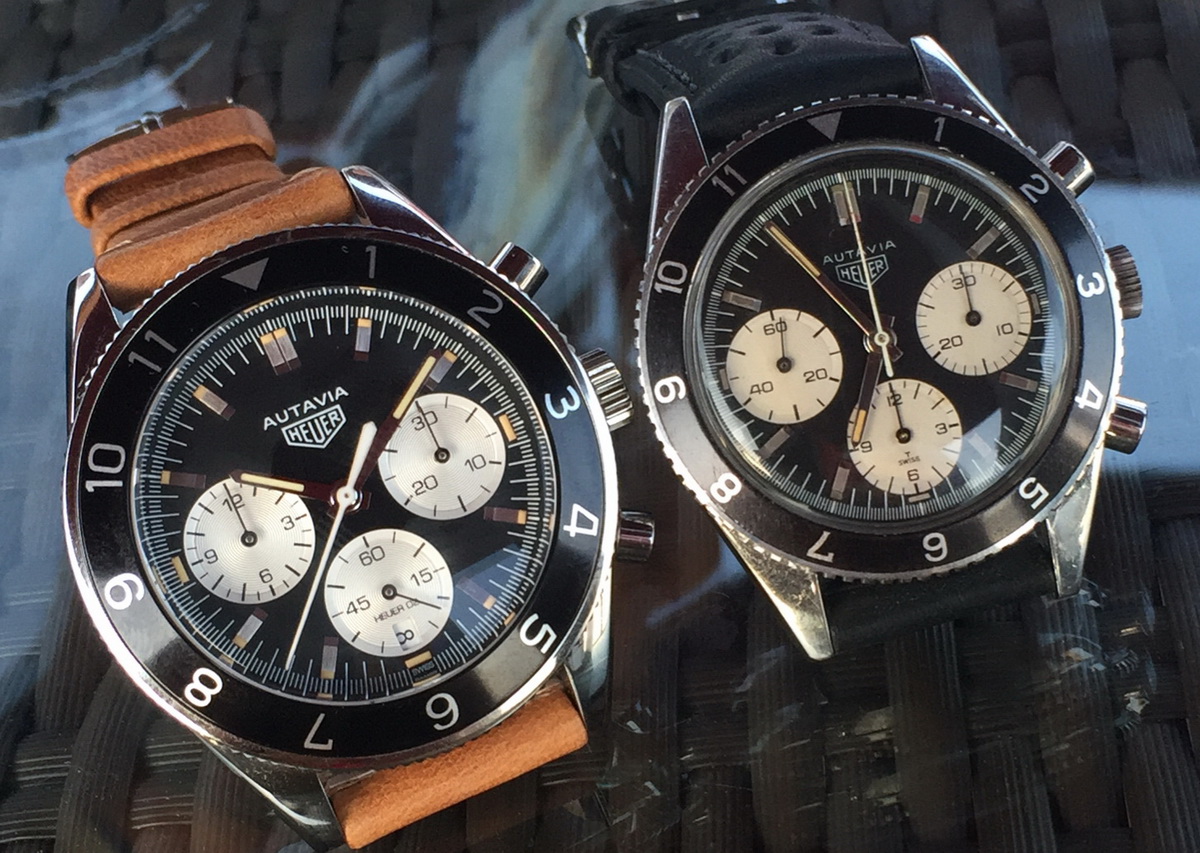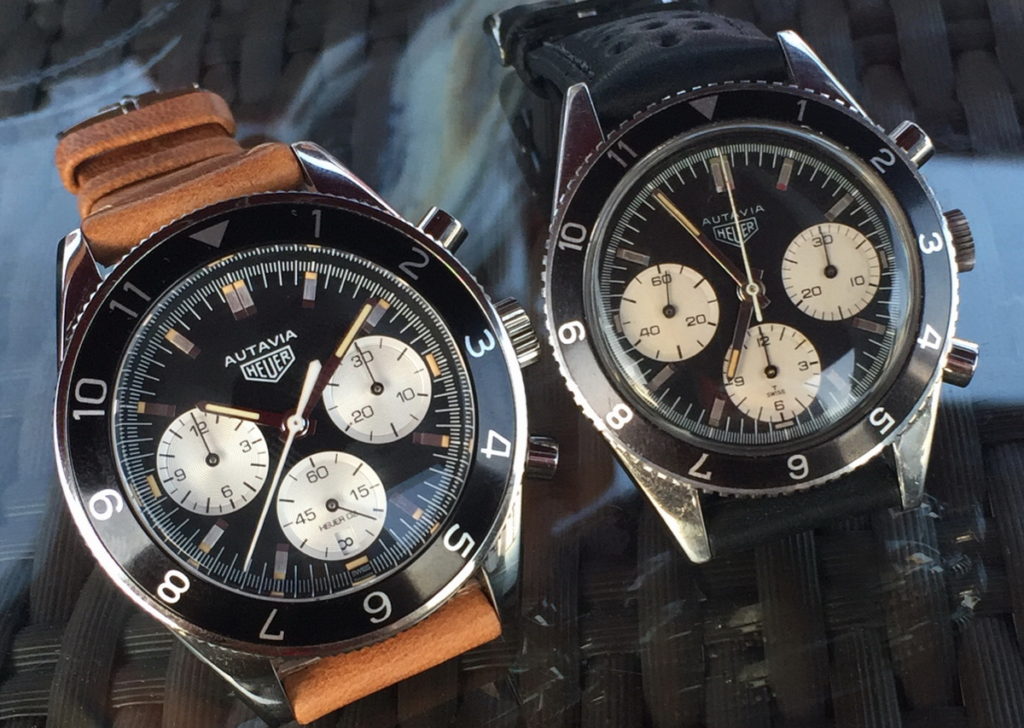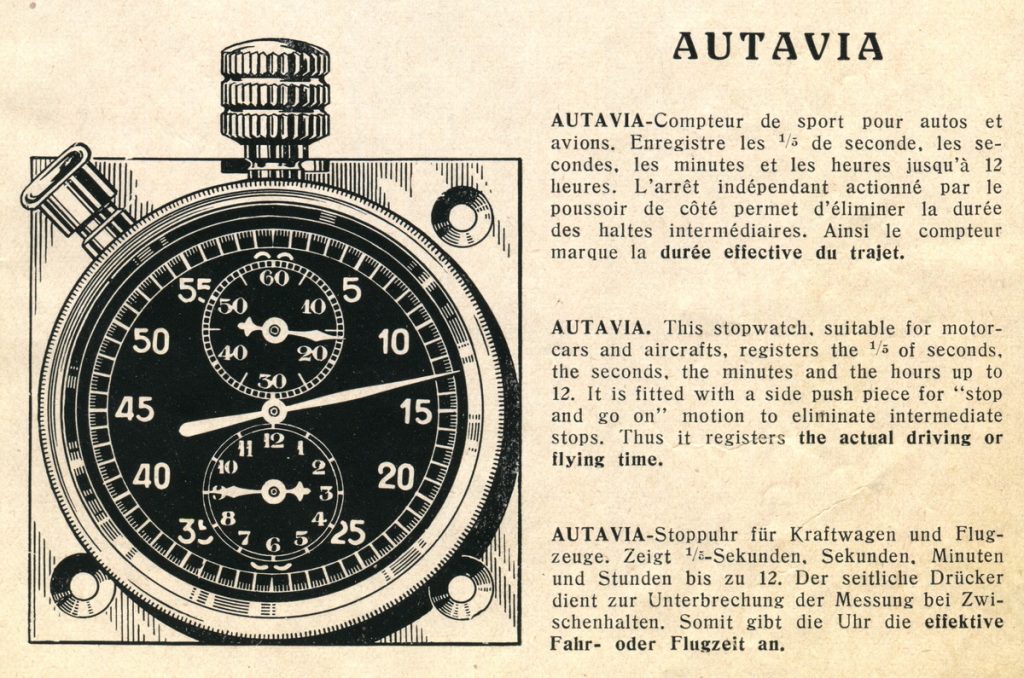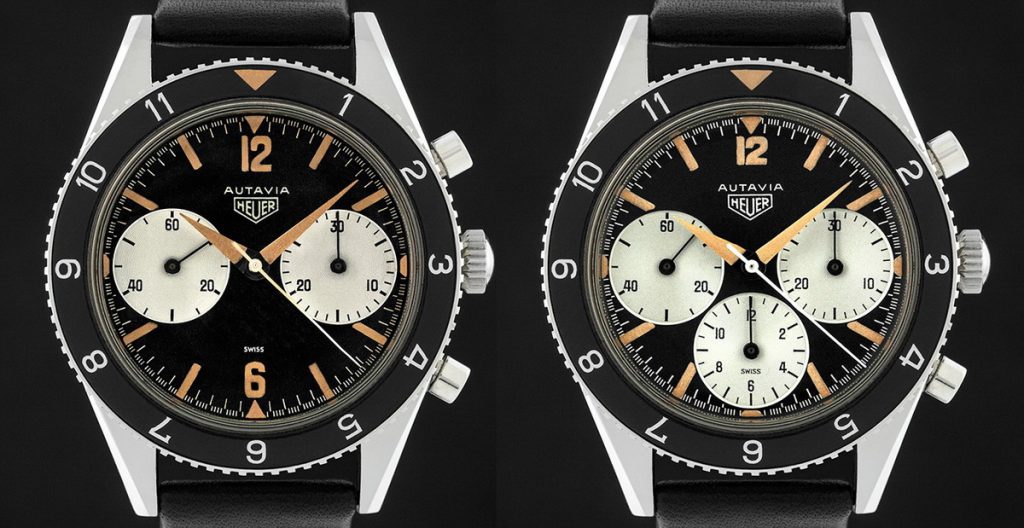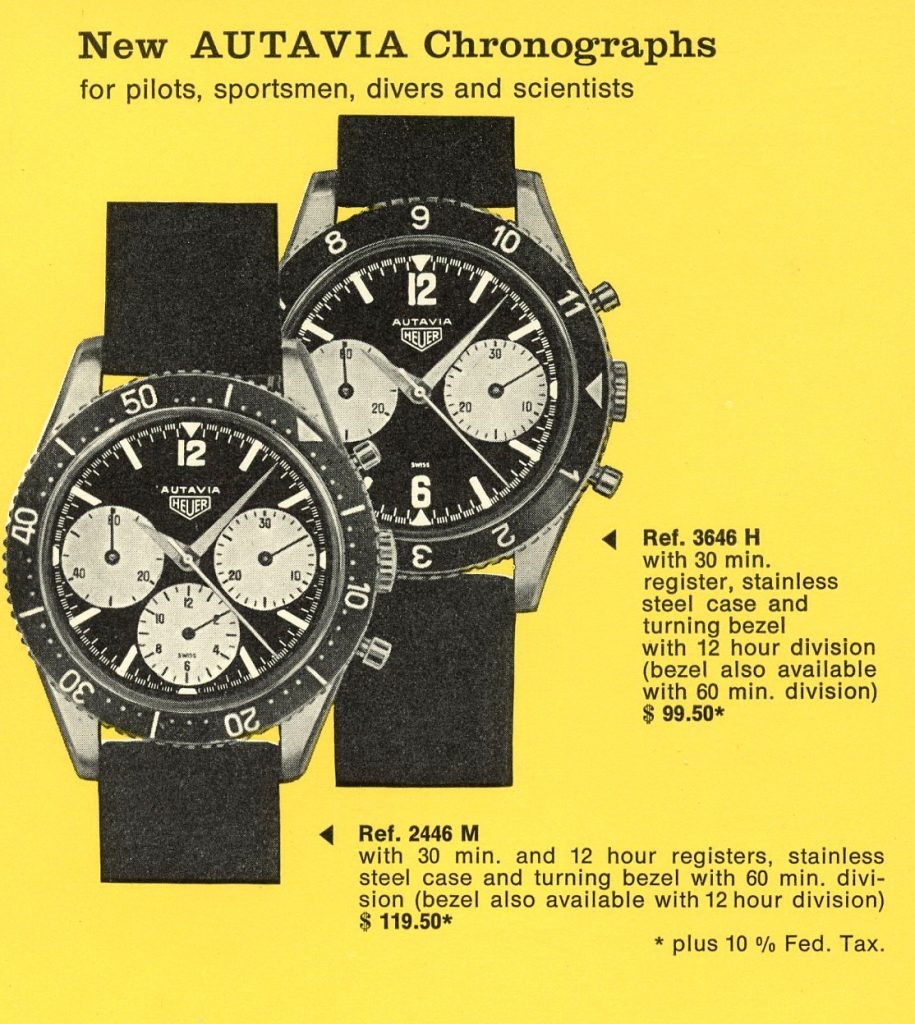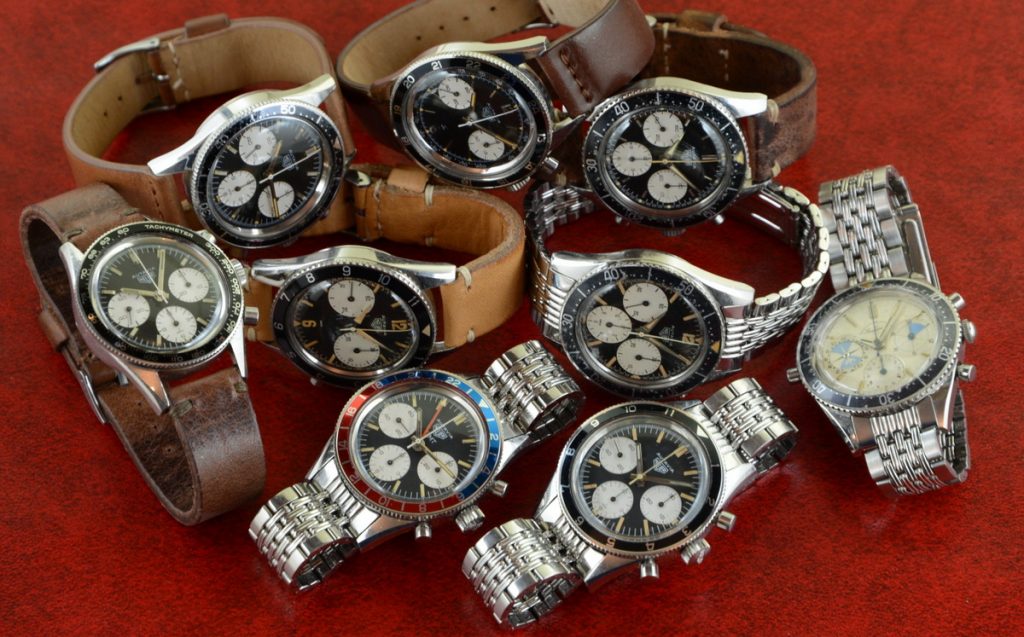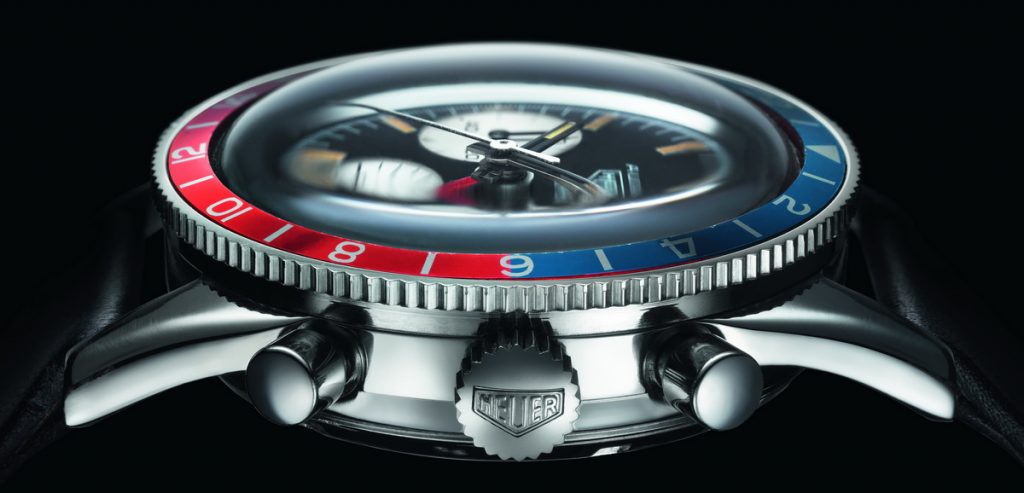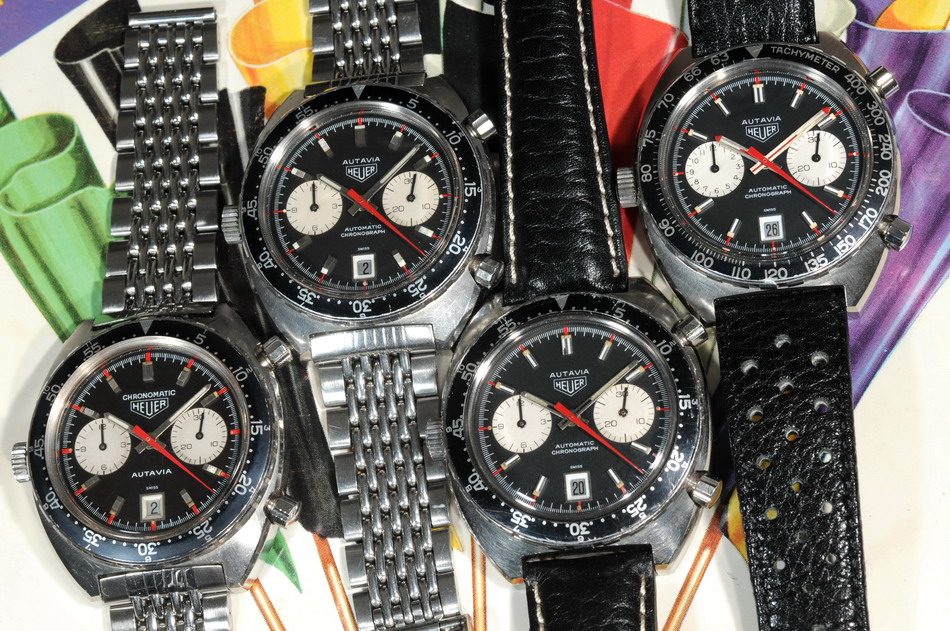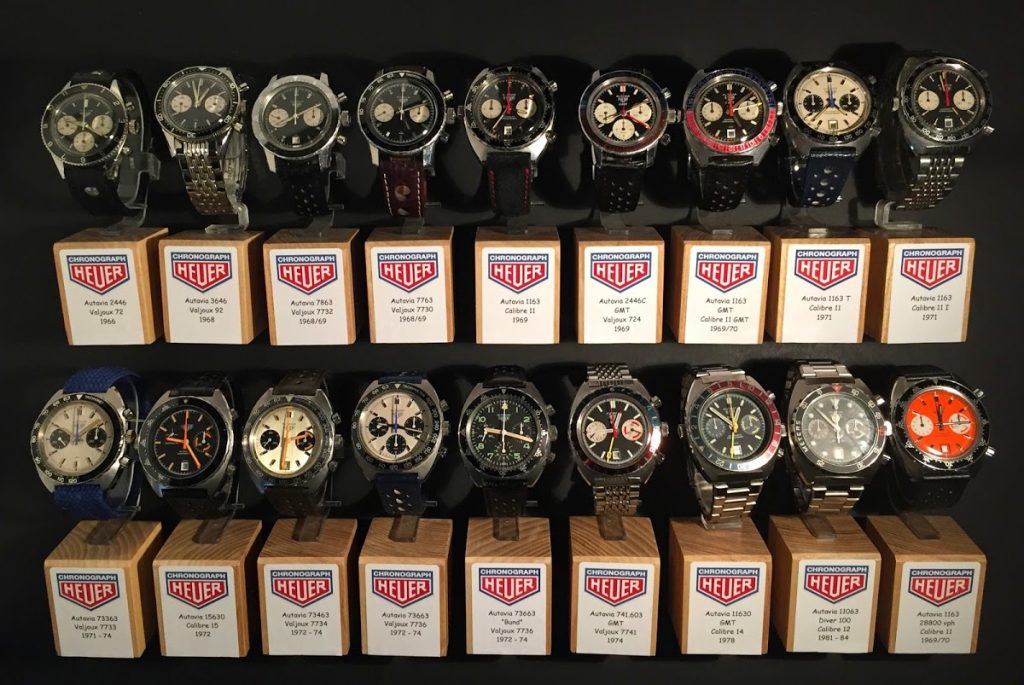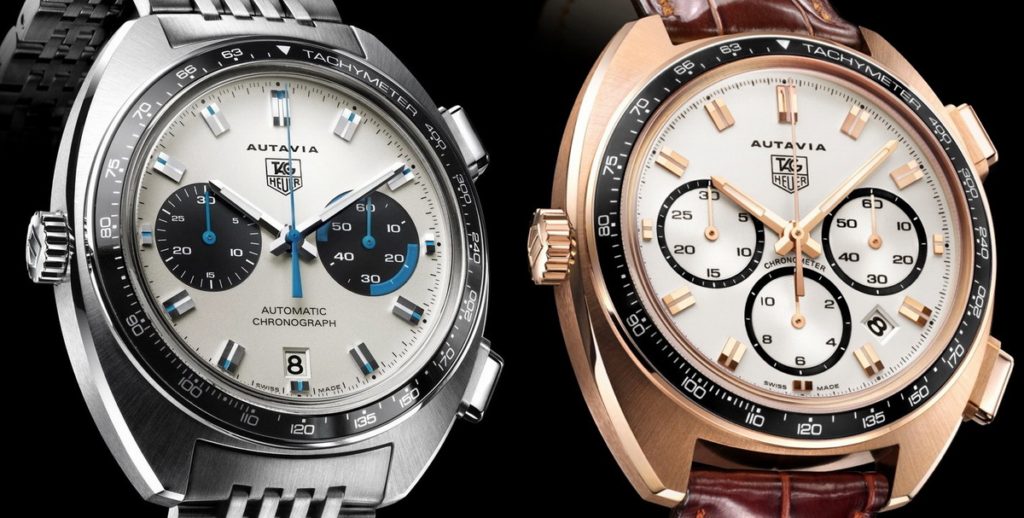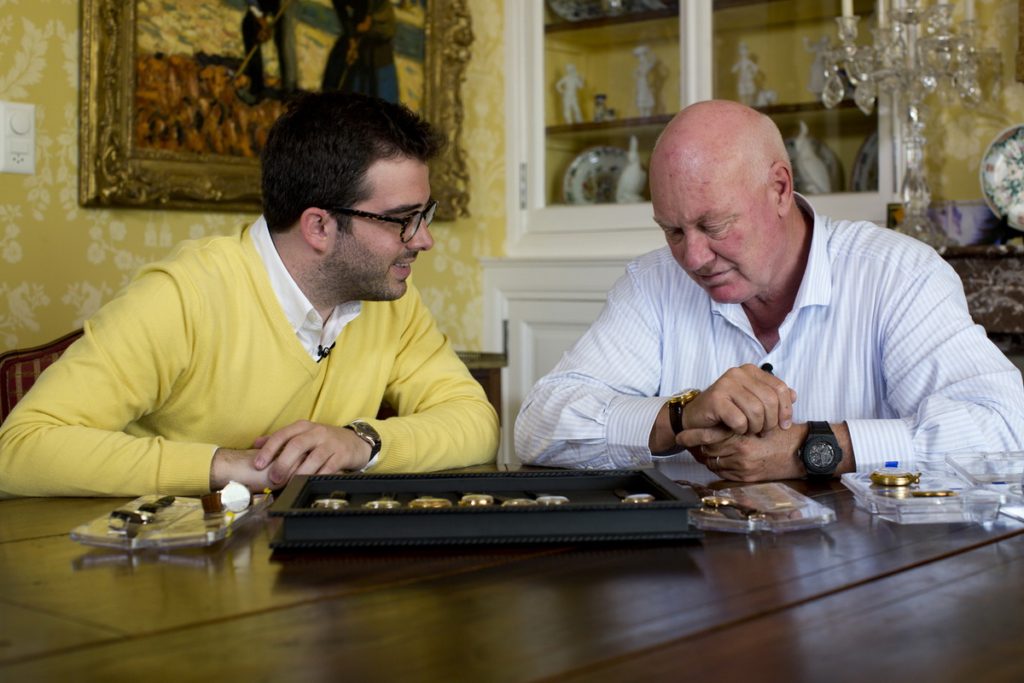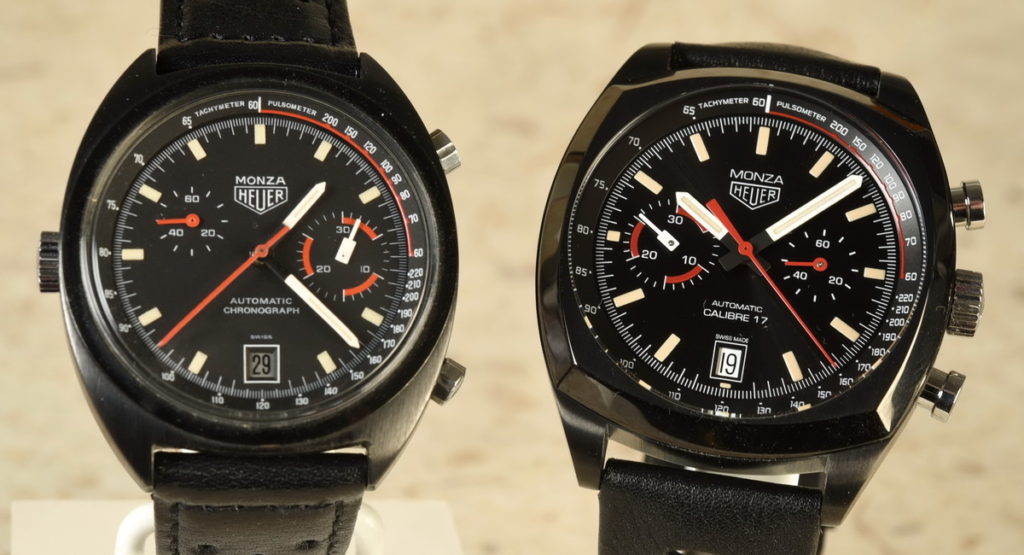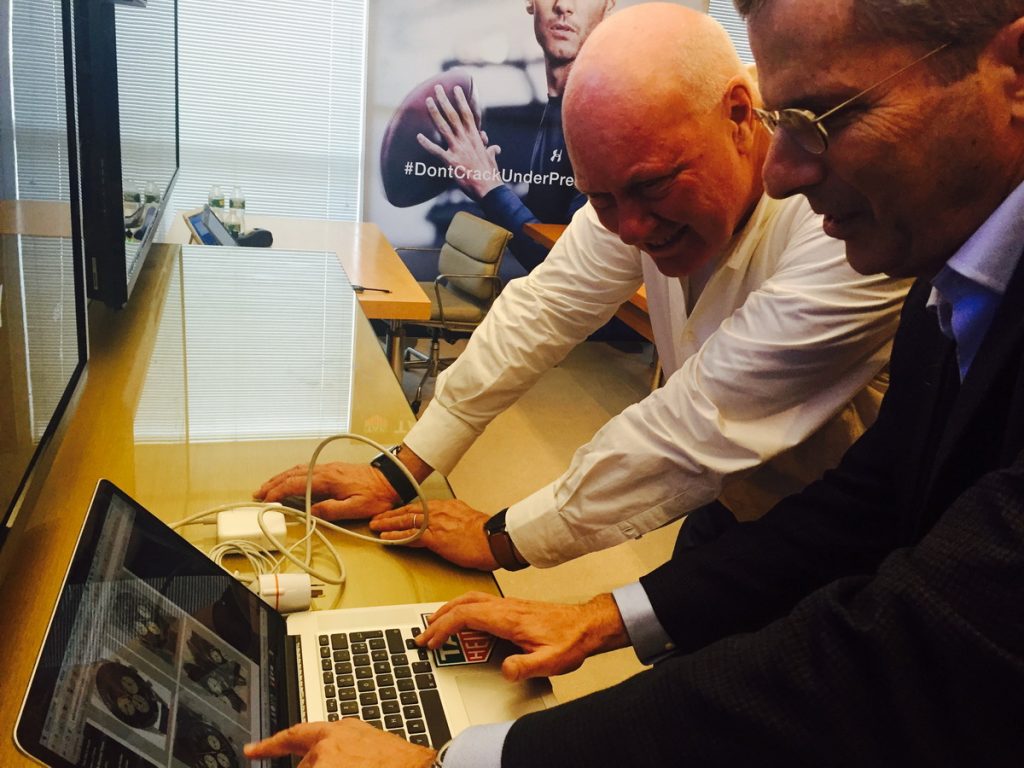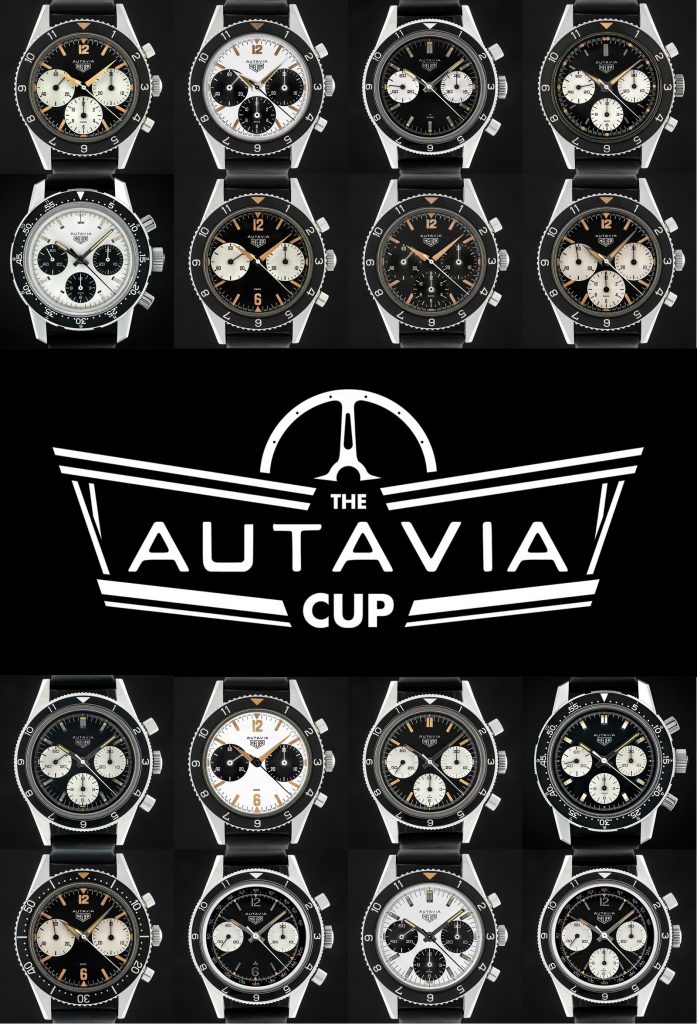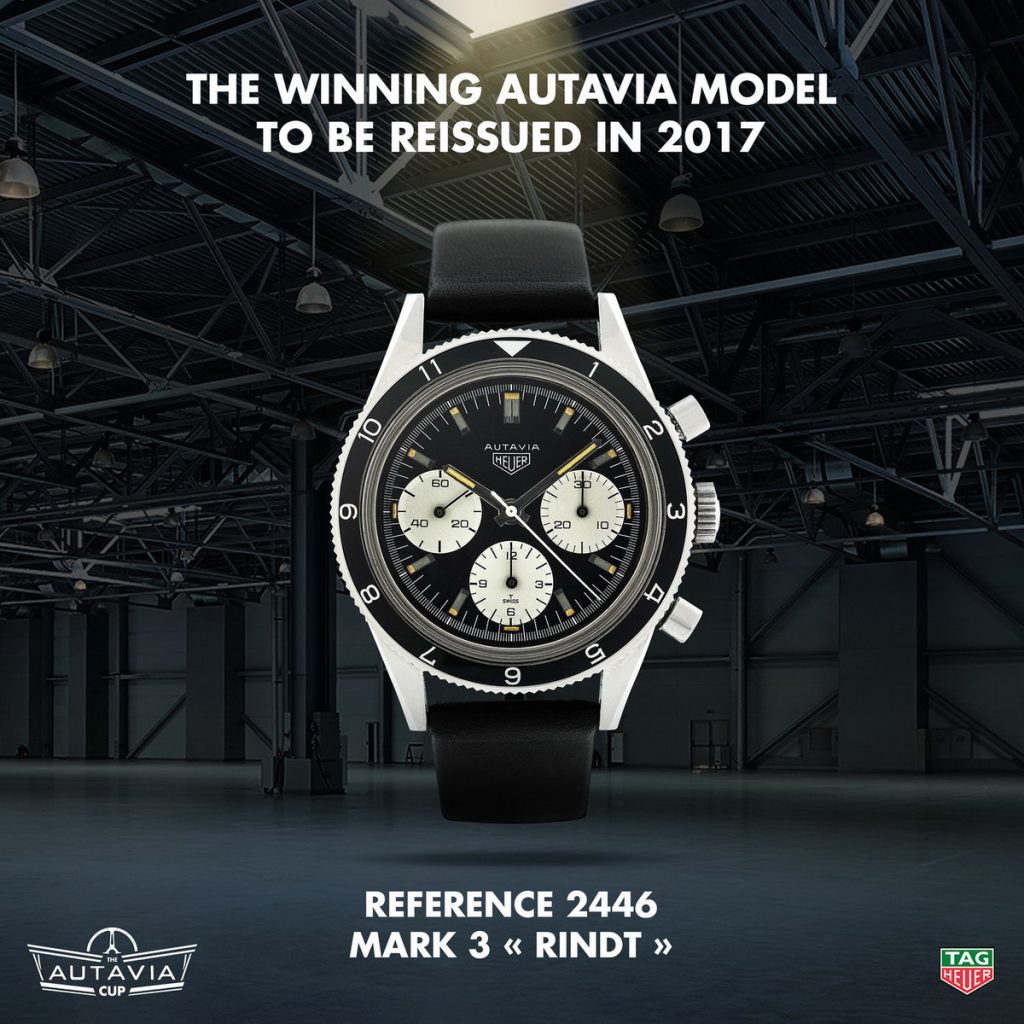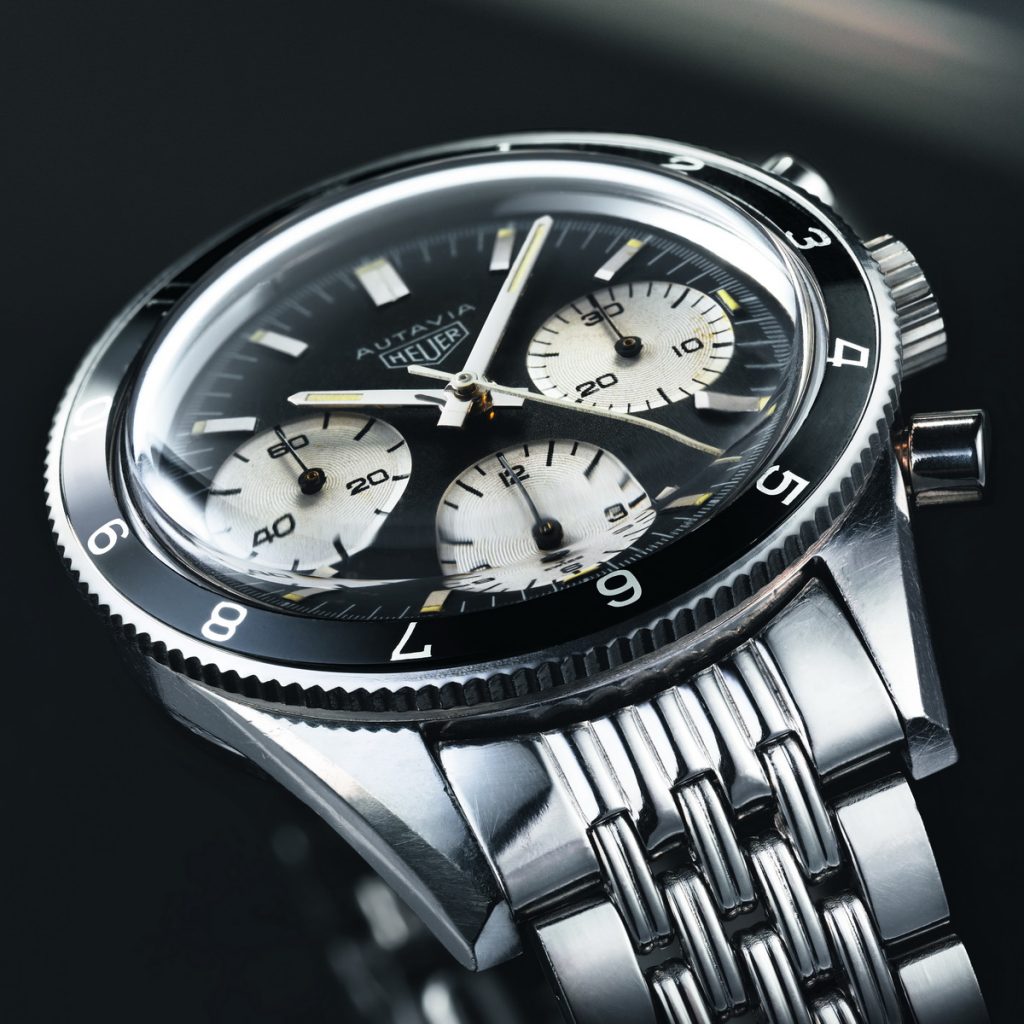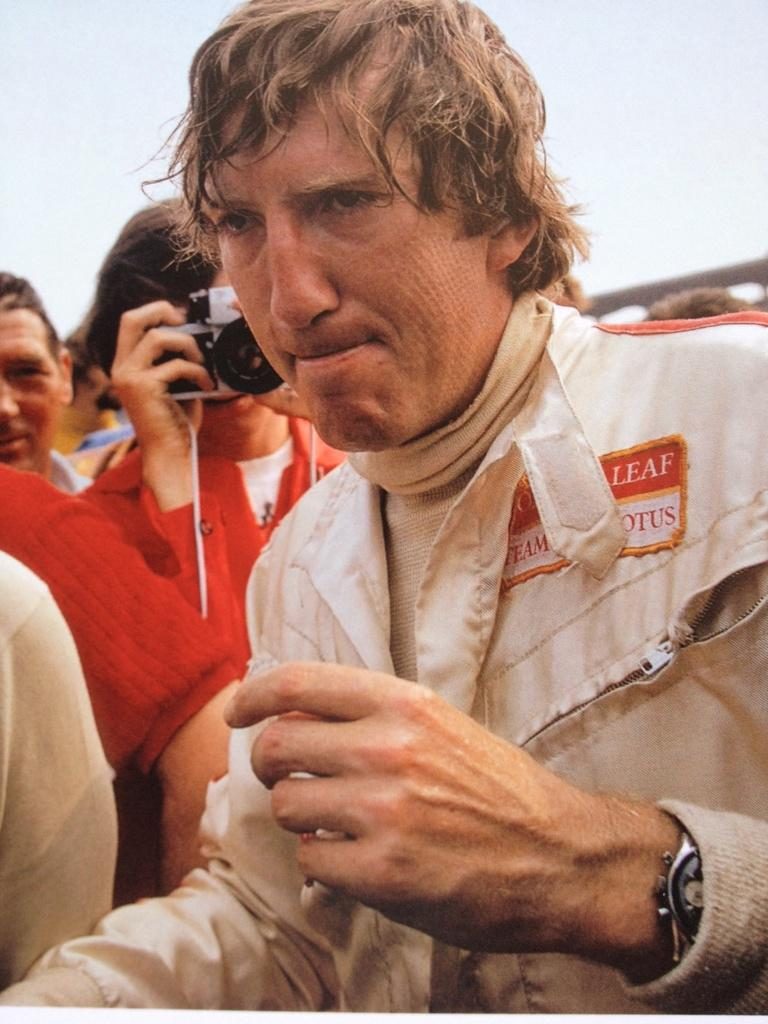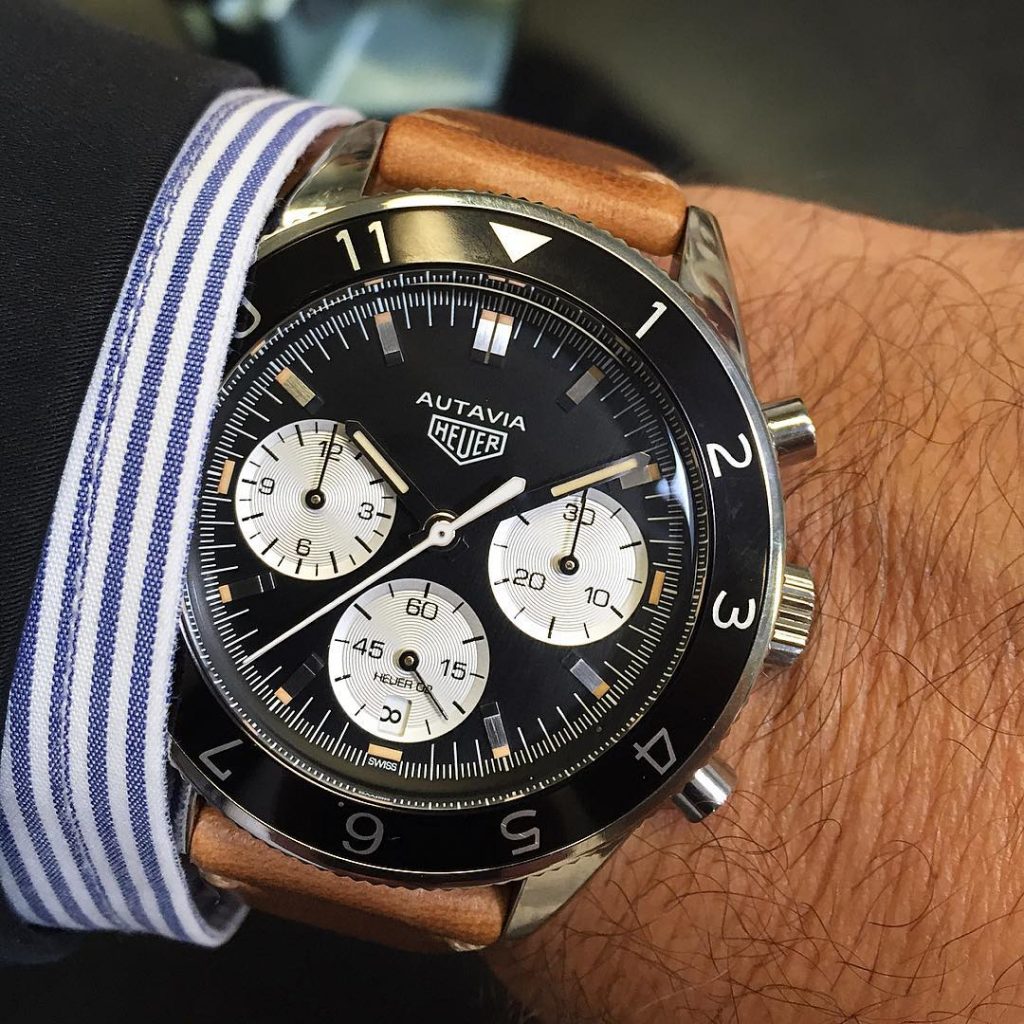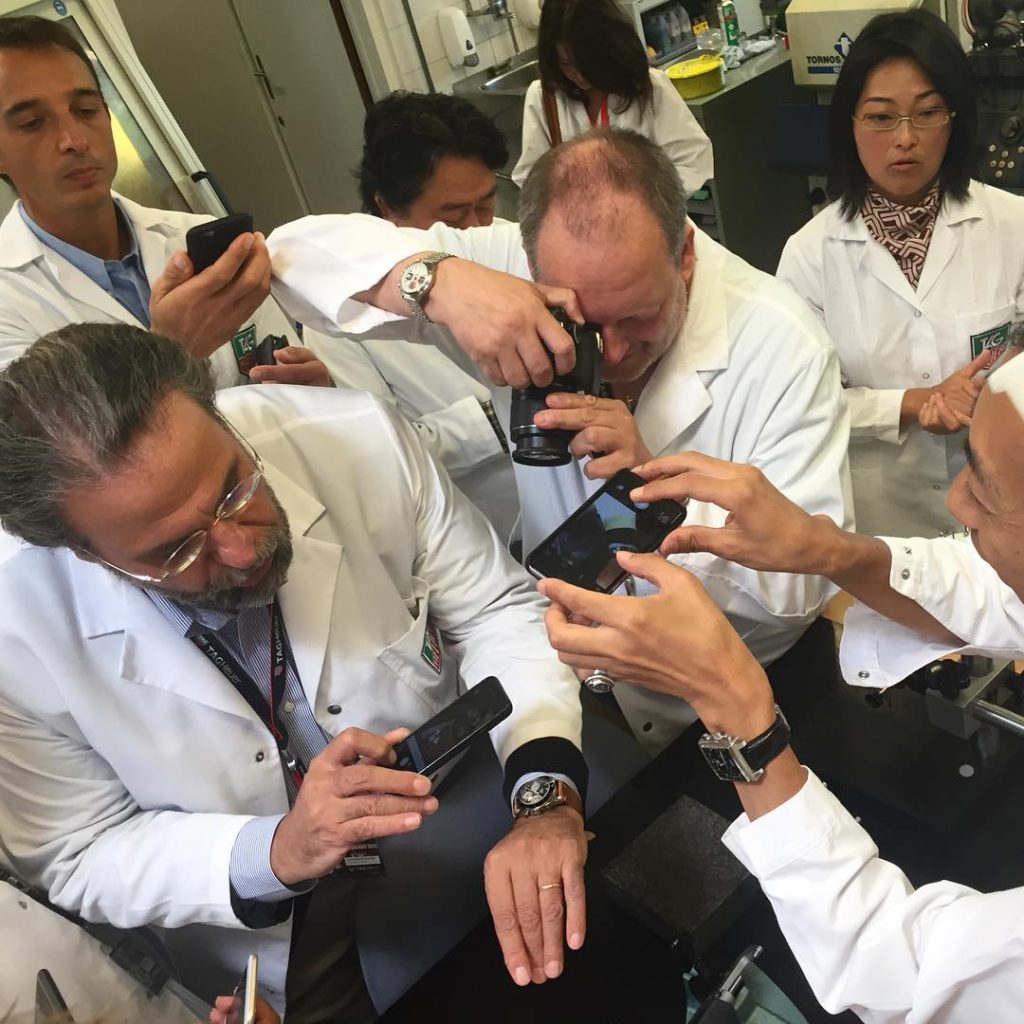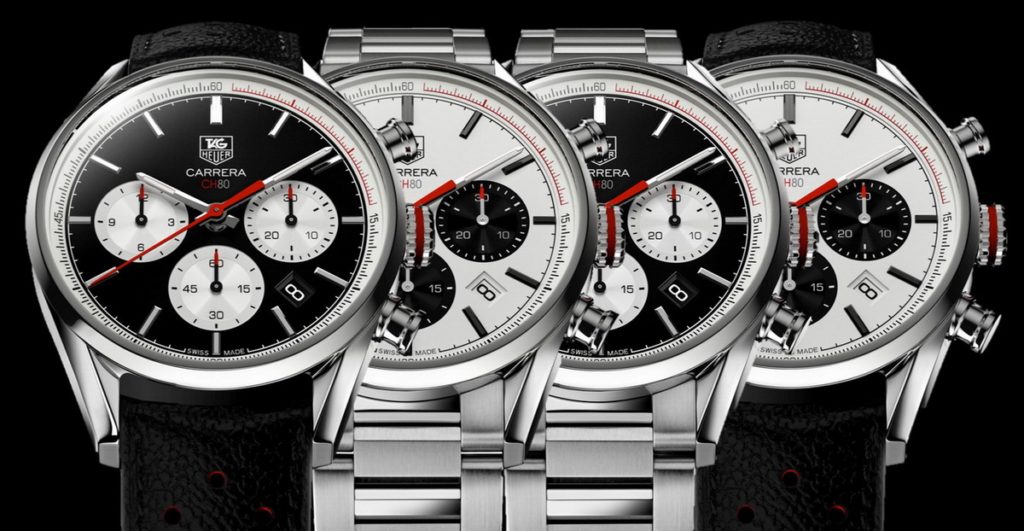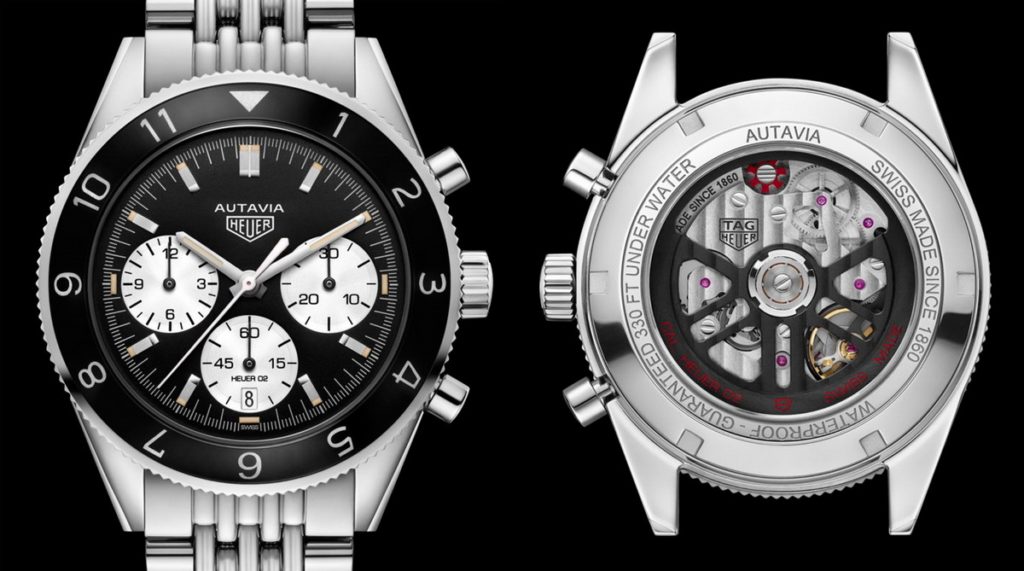Three days from now, on March 23, 2017, TAG Heuer will introduce its new Autavia, at the Baselworld show. Today, we provide the essential background information to introduce the newest member of the TAG Heuer family. While we are confident that the new Autavia will stand on its own, it may look even better to those who appreciate the watch’s rich history.
Origin of the Species – The Autavia Dashboard Timers
Heuer launched its first Autavia in 1933, using the name for a dash-mounted timer with 12-hour stopwatch capacity. The name “Autavia” combined the words AUTomobile and AVIAtion, as these Autavias were designed to be mounted on the dashboards of race cars and airplanes.
Heuer produced the dashboard Autavias through the 1950s, with movements, dials, hands and cases evolving from one decade to the next. All these dashboard Autavias shared the 12-hour stopwatch feature, with a central crown to wind the watch and for the start / stop functions, and a side-mounted pusher to reset the timer to zero.
Overview of the Autavia Chronographs – 1962 to 1985
Heuer redesigned its 12-hour dashboard timer circa 1958, with the new Monte Carlo replacing the Autavia in the Heuer line-up. So when Jack Heuer designed his first chronograph for racers, the name “Autavia” was available for the new model. Heuer introduced its first Autavia chronographs in 1962, with two models in the catalog.
The three register model had a 12-hour recorder, and was shown in the catalog at $119.50; the two register model had a 30-minute recorder, and was shown in the catalog at $99.50.
Through the 1960s, Heuer offered approximately 30 versions of the Autavia chronograph, all with manual-winding Valjoux movements, in traditional round cases. The defining featuring of the Autavia, both in these first models and in the models that would follow, was the rotating external bezel, which provided an additional tool for the driver, pilot, diver, traveler or baker.
Over the course of the 1960s, screw-back cases yielded to compressor cases; dauphine hands were replaced by stick hands; over-sized registers shrunk to became a more standard size; and a GMT (second time zone) model was added to the catalog.
In 1969, Heuer introduced the world’s first automatic chronographs, with three models using the new Caliber 11 movement – the Autavia, the Carrera and the Monaco. The Monaco was a new model for Heuer, with its unique square case specifically designed to house the new movement. The cases for the Autavia and Carrera were redesigned, to accommodate the larger automatic movement, both being C-shaped cases. The Carrera used an inner tachymeter bezel, while the Autavia continuing to employ the outer rotating bezel. While the previous Autavias used only black dials, Heuer offered the new automatic Autavias in a choice of black and white dials.
Over the course of the 1970s into the 1980s, Heuer offered the Autavias with a dizzying variety of cases, dials, hands, movements and configurations, to bring the total number of versions for the Autavia to a total of over 90 models over the period from 1962 to 1985.
The First Re-Issues of the Autavia – 2003
TAG Heuer produced a re-issue of the Autavia in 2003, using a C-shaped case with a fixed (non-rotating) tachymeter bezel. There were stainless steel versions in the classic white and blue of the 1970s Jo Siffert Autavias, as well as one with a black dial and orange accents, another popular color scheme from the 1970s. An 18 karat gold model offered three registers and a date, with black accents. These first re-issues of the Autavia did not appeal to the vintage enthusiasts at the time when they were released, but have become more collectible in recent years.
Welcome Jean-Claude Biver
Jean-Claude Biver was named Head of Watchmaking for the LVMH brands (Hublot, TAG Heuer and Zenith) in January 2014 and became CEO of TAG Heuer in December 2014. TAG Heuer watchers knew that with the appointment of Jean-Claude Biver as CEO for TAG Heuer, it would not be business as usual. Yes, everyone knew of Mr. Biver’s passion. And yes, everyone expected him to energize LVMH’s most youthful brand. But perhaps the most significant aspect of Mr. Biver’s new role is that Mr. Biver is a “watch guy”. And more than just being a watch guy, Jean-Claude Biver is a “vintage watch guy”, having an exceptional collection of important watches. (For an introduction to Mr. Biver’s collection and his appreciation of exceptional vintage watches, see this episode of Talking Watches on Hodinkee).
It wouldn’t take long for Jean-Claude Biver to begin to leverage the Heuer heritage, dedicating significant resources to the TAG Heuer Museum and archives, and focusing on the company’s workshop for vintage models. Introduced at Baselword 2016, the TAG Heuer Monza would be the first new watch of the Biver era that was inspired by Heuer’s vintage portfolio. The new Monza was not a copy of the vintage Monza, but drew inspiration from its 1970s predecessor. (See my review of the 2016 TAG Heuer Monza, in Watch Journal, Volume 19, Number 9.)
The 2017 Autavia – The People’s Choice
With TAG Heuer having produced modern versions of the Carrera, Monaco, Silverstone and Monza, collectors wondered when Mr. Biver would turn his attention to the Autavia. The answer to this question came quickly. In the Fall of 2015, the market for the vintage Autavias was exceptionally strong, and when I met Mr. BIver in November 2015 (at the launch of the TAG Heuer Connected Watch), I asked him the question, “So why don’t you do a re-issue of the Autavia”? I suspect that I was not to first to ask this question, and his answer came quickly – “Tell us which one you want, and you will have it in March 2017.”
As we browsed the Autavias shown OnTheDash, Mr. Biver added that there were only two conditions to this commitment. First, the new Autavia had to have a classic round case, in the style of the 1960s Autavias, rather than the C-shape case of the 1970s Autavias. Second, the 2017 Autavia had to be a modern-sized watch, likely in the range of 42 millimeters, rather than the sub-40 millimeter size of the predecessors. Subject only to these two requirements, the community of enthusiasts could select the vintage model that would inspire the new Autavia.
In December 2015, the social media team at TAG Heuer proposed a novel approach through which enthusiasts would select the historic model that would inspire the new Autavia. The “Autavia Cup” would be a head-to-head competition between 16 of the 1960s Autavias, with enthusiasts voting on their favorites in three rounds. Of the 16 Autavias included in the Autavia Cup, 12 were models that Heuer actually produced in the 1960s and an additional four were created through PhotoShop (for example, a black-on-black model, with black registers on a black dial).
The first round would narrow the field to eight watches, the second round bring it to four, and TAG Heuer would then select the winner based on the voting in the third (final) round. With the Autavia Cup, TAG Heuer employed a unique approach to choosing the historical precedent that would inspire a modern watch, and the competition was an overwhelming success, with over 55,000 votes being cast through TAG Heuer’s dedicated Autavia Cup microsite.
On April 18, 2016, TAG Heuer announced the winner of the Autavia Cup — a three-register Autavia, in the second execution screw-back case, with the third execution Mark 3 dial (circa 1966). This was the model worn by Formula One world champion Jochen Rindt, so that collectors simply refer to the model as the “Rindt Autavia”.
The Racers Autavias – Jochen Rindt and Mario Andretti
Defining elements of the “Rindt” Autavia include the bezel, which was narrower on the second execution case than on either of the first execution screw-back case or the later compressor case; the applied steel markers, with luminous material at the ends; and the polished matchstick hands, with luminous inserts. The “Rindt” Autavia was available with a choice of three bezels, marked for hours, minutes or the tachymeter scale.
It is fitting that the Autavia Cup winner was the Autavia worn by a Formula One World Champion, and also notable that another Formula One champion, Mario Andretti, wore the same model, only in the two-register configuration. Throughout the 1960s, the Autavia was the chronograph most often worn by the racers, and in choosing the “Rindt” model of the Autavia as the winner of the Autavia Cup, Heuer enthusiasts evoked the Autavia’s racing heritage, another defining characteristic of the 1960s Autavias.
From the Autavia Cup to Baselworld
Since April 2016, when TAG Heuer announced that the “Rindt” model had won the Autavia Cup, enthusiasts have wondered how close the 2017 Autavia would be to its vintage predecessor. At the opening of the TAG Heuer Collectors Summit, September 11, 2016, Jean-Claude Biver offered remarks about the new Autavia that served to introduce the prototype that Summit participants would see the next day. Biver was emphatic that TAG Heuer was not in the business of copying its classic models, and that the new Autavia was inspired by the original Rindt model, but would not be a copy of that model. The new Autavia would be automatic, the new Autavia would be a modern-sized watch, and it would have a date, also consistent with the demands of today’s market. (This posting provides a transcript of Mr. Biver’s comments at the Summit.)
The next morning, Summit participants — and, by social media, the rest of the world — saw a prototype of the new Autavia. Initial impressions were very favorable – it was in fact an honest interpretation of the “Rindt” Autavia, in a 42 millimeter case. (And for those who study the photos of this prototype carefully, the reason that the date “8” appears horizontally in the vertical date window is that this prototype was assembled in great haste, to be ready for the Summit.)
The basic elements of the Rindt were all there – tri-compax layout of three white registers on the black dial; the size and finish of the registers, the style of the markers and hands, and even the triangular knurled edge of the rotating bezel. Perhaps the most noticeable change from the original Rindt was the width of the bezel. Still, the enthusiasts accepted this new element as being within the designer’s license in creating a modern version of a historic model.
A New Motor for the New Racer
The release of a new Autavia this Thursday will mark another important milestone for TAG Heuer – the introduction of its Heuer 02 in-house movement. While the Calibre 1887 has become TAG Heuer’s chronograph movement of choice over the last seven years, with the Heuer 02 movement, TAG Heuer will be introducing something the vintage enthusiasts have been clamoring for, since TAG Heuer initiated its re-issues of the classics over 20 years ago. Yes, the Heuer 02 movement has a tri-compax, 3-6-9 dial configuration, as used by Heuer throughout the decades from the 1940s through the 1970s.
We trace the name “Autavia” to 1933, and we trace the Heuer 02 movement to 2013, when TAG Heuer first mentioned that it would develop a companion to its Caliber 1887 movement, with the new movement first called the “Caliber 1888”. The new movement was soon renamed Caliber 1969, and used in early 2014 for a limited edition Carrera, in black PVD titanium carbide coated titanium and 18k rose gold case. At Basel 2014, the movement returned as the “CH80”, powering the all-new Carrera CH80. Vintage enthusiasts celebrated – at last, TAG Heuer had an in-house movement to power tri-compax chronographs. Here is our posting covering the introduction of the Carrera CH80, in 2014
This euphoria from the Carrera CH80 was short-lived, however, as in June 2014, TAG Heuer announced that it would delay the use of the CH80 movement, in order to optimize its production of the Calibre 1887. Some speculated that this “delay” might be a nice way of burying the new movement. With the use of the Heuer 02 to power the new Autavia, we see that the delay was exactly that, a three-year pause while TAG Heuer developed the capacity to produce two in-house movements, the Calibre 1887 and the Heuer 02.
The tri-compax layout of the Heuer 02 movement makes it ideal for other vintage-inspired chronographs, with enthusiasts expecting to see retro-inspired Carreras soon joining the TAG Heuer portfolio. The new movement’s relatively simple construction and modular design will allow it to support other complications, raising hopes that we may soon see a GMT Autavia or a triple calendar chronograph. So beyond being a new movement in a new Autavia, March 23, 2017 may mark the beginning of an entirely new portfolio of TAG Heuer chronographs.
March 23, 2017 – Mark It on Your Calendar
Thursday, March 23, 2017 will be an important day in the history of the TAG Heuer brand. Combining a name from 1933, a racer’s watch from 1967, and a movement from 2017, we will see a new chronograph that embodies the brand’s winning portfolio of racing chronographs. Enthusiasts are optimistic that this will mark the beginning of a new era for the Autavia, and [to be added].
What We Are Expecting – TAG Heuer Autavia Heuer 02 (“2017 Autavia”)
- Three register, automatic chronograph, in 42 millimeter case, water resistant to 100 meters, with in-house Heuer 02 movement
- Dial — Black, with three white registers; registers have azurage finish
- Chronograph hours at 9 o’clock
- Chronograph minutes at 3 o’clock
- Running seconds at 6 o’clock
- Markers — Applied metal markers, with luminous material at ends
- Date —window within running seconds register, at 6 o’clock
- Hands — Polished “matchstick” hands for hours and minutes, with luminous inserts
- Case – Steel case with
- bi-directional rotating bezel, marked in hours (1 through 12)
- anti-reflective sapphire crystals front and back
- Crown – steel with TAG Heuer logo
- Pushers – capped style, pump pushers in polished steel
- Movement – Heuer 02, column wheel chronograph, with vertical clutch
- 33 jewels
- 13-3/4 ligne, with thickness of 6.9 mm
- frequency is 4 Hz (28,800 vph)
- 80 hour power reserve
- Strap — Brown perforated leather strap, with black titanium carbide coated titanium clasp, or stainless steel double “grains of rice” bracelet.
- Suggested retail price — $5,500
Jeff Stein
March 20, 2017
